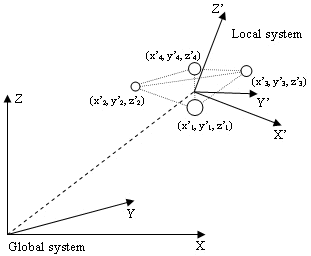Definition of local coordinate system
When you have defined the points of the 6DOF body in QTM you can change the definitions of the local coordinate system. The local coordinate system is by default placed in the geometric center of the points.
The local coordinate system is used in the calculation of rotation and position of the measured rigid body in reference to a reference coordinate system. Therefore it is important that the local coordinate system is defined according to the specifications of the measurement. The local coordinate system should have an orientation and a location in reference to the points in the 6DOF body definition, which is well-defined. Use a definition where the normal orientation of the body is the same as no rotation, i.e. aligned with the reference coordinate system.
When you have decided where the local coordinate system should be, use the Translate and Rotate functions on the 6DOF Tracking page to specify the local coordinate system, see chapter Rigid bodies.
Then you should also decide which coordinate system that the 6DOF body data should refer to. This done in the Coordinate system for rigid body data dialog, which is opened by double-clicking on Global origin on the 6DOF bodies page. See chapter Coordinate system for rigid body data for the alternatives.
If you want to change these setting in a capture file you must reprocess the file with the new setting.
